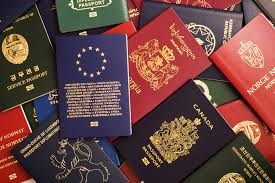Travelling to Asia is awesome. You get to see vibrant cities and different cuisines. Learn more on the “2025 Guide to Apply for an International Passport To Asia”.
In 2025, are you going to Asia? Whether you want to study in Seoul, pursue a profession in Singapore, visit the vibrant streets of Tokyo, or take in the rich culture of Bali, you must prepare your international passport.
Let’s face it: if you’re applying for a passport for the first time, the process can seem like a maze. It’s simple to become overwhelmed by the amount of paperwork, taxes, and bureaucratic red tape.
Don’t worry, though. I’ve got you. This is your concise, no-nonsense guide to getting an international passport in 2025, designed specifically for travelers who intend to visit any Asian country.
Get your international passport today
2025 Guide to Apply for an International Passport To Asia
We’re keeping things straightforward, intimate, and genuine.
First Things First: Is a Passport Really Necessary to Travel to Asia?
Indeed. Every Asian nation, including China, Japan, South Korea, the United Arab Emirates, and Thailand, requires visitors to show a valid passport at the time of admission. Not just any passport, either. The majority of Asian nations need:
- A passport that is good for at least six months after the date of travel
- A minimum of one or two blank pages for visas or entry/exit stamps
So, if your travel document is soon to expire, or you do not possess one at all, now is the moment to act.
Step 1: Recognize the Type of Passport Application
Generally speaking, you fall into one of two situations:
- It’s your first time having a passport.
- One was yours, but it’s broken, lost, or expired.
Although the standards for renewal are frequently less stringent, you will still need to go through an official request process in both situations.
The methods are fairly similar if you’re renewing; in most countries, you only need to skip the biometric/data capture portion. This tutorial is primarily for first-time applicants.
Step 2: Get the necessary paperwork ready
The majority of passport offices request some form of the following, though specific requirements differ from nation to nation:
- Evidence of nationality, such as a citizenship certificate, national identity card, or birth certificate
- Two current passport-sized photos with a plain background and a neutral expression
- filled-out application (printed or completed online)
- Evidence of residency or address
- Application fee or payment receipt
- consent from your parents (if you’re a minor)
Pro tip: Double-check your nation’s official customs website for an accurate list. What was effective a year ago may not be applicable today.
Step 3: Take Correct Photos for Your Passport
Don’t undervalue this section. Numerous applications are either denied or delayed due to photo problems alone.
This is how your passport photo ought to appear:
- taken within the last six months
- Clear, excellent quality image (no filters, no blurring)
- Full face visible, looking directly at the camera
- No headgear, hats, or glasses (unless required by religion)
Use a government-recommended photo booth or visit a legitimate picture studio. If you don’t know exactly what you’re doing, don’t DIY.
Step 4: Carefully complete the application form.
Applying online is now possible in several nations that have gone digital. Others demand that you print or pick up a form.
Here’s something to keep in mind:
- If the form is handwritten, fill it out in BLOCK letters.
- Be consistent with your information. Your name must be exactly the same as it appears on your birth certificate or national ID; it cannot be shortened or misspelled.
- Before submitting, make sure everything is correct.
Any mistake, no matter how small, can cause your application to be rejected or delayed.
Step 5: Cover the cost of the passport
Passport fees vary by country, speed of processing, and amount of pages. Here are some general predictions for 2025:
- 32-page standard passport: $25 to $70
- $50 to $120 for a large passport (64 pages)
- Express processing often costs between $30 and $100 more.
Use official payment methods at all times, such as secure internet portals or recognized banks. You’ll need the payment receipt for submission, so keep it secure.
Step 6: Schedule a Meeting (If Necessary)
Walk-ins are not always accepted at passport offices. Before you may appear for biometric capture, several countries now ask you to make an online appointment.
Typically, appointments are scheduled via official government websites. When choosing a date, make careful to:
- Get there at least half an hour early.
- Bring copies of all original documents.
- You will be photographed, so dress nicely and in neutral hues.
Step 7: Proceed with Biometric Submission and Capture
The actual processing starts at this point. When you get to the visa office, you’ll likely go through:
- Verification of documents
- Biometric data collection (pictures, signatures, fingerprints)
- Brief interrogation or interview
It’s simple. A few standard inquiries, such as where you’re going or why you need a passport, might be asked by the authorities. Be self-assured and truthful.
Step 8: Hold on
Processing timelines may vary from five business days to six weeks, contingent upon:
- Country Application volume
- Whether you paid for faster service
Typically, you will receive an email or SMS when your passport is prepared. You can even follow the progress online in certain workplaces.
Step 9: Get Your Documents
When picking up your passport, make sure to include your ID and application receipt. Some locations let someone else pick you up, but they’ll need to show their own ID, a copy of your ID, and an authorization letter.
Prior to leaving the counter, make sure:
- The spelling of your name is accurate.
- The birthdate is correct.
- The passport number is visible and corresponds to the documents you have.
- You own the picture.
Your trip plans could be ruined if you make mistakes here.
Bonus Tip: Verify the Asian country you’re visiting’s visa requirements.
Access to your destination is not guaranteed just because you have a passport. The majority of Asian nations require a visa, though some allow certain nationalities to enter without one or upon arrival.
Always make sure:
- Is a visa required to enter this country?
- Is it a work permit, student visa, or tourist visa?
- How long will you be staying?
- Are there any limitations on entry? (Vaccinations, COVID-19, etc.)
You don’t want any surprises at the entry desk, I assure you.
Commonly Asked Questions
Is it possible to apply for a passport solely online?
A: You must still appear in person for biometric capture even though the application process in many countries begins online.
What would happen if I misplaced my old passport?
A: police report must be presented, and depending on your nation, you may also be required to swear an affidavit.
What is the duration of a passport?
A: Usually five to ten years, depending on the policy in your nation and the holder’s age.
Can a minor obtain a passport?
A: Yes, although consent from parents or guardians is required, and the youngster may need to be present in person.
Last Remarks
Applying for a global passport does not have to be an ordeal. If you keep prepared, prepare your paperwork beforehand, and follow the appropriate instructions, you’ll have your travel permit in no time.
Asia is awaiting. One important document – your passport – is the first step on any travel, whether it takes you to the temples of Kyoto, the skylines of Dubai, or the street food vendors of Bangkok.
Get started right away. Avoid waiting until a few weeks before your flight. Additionally, don’t treat your brand-new passport as merely a piece of paper when you finally hold it in your hands. Consider it your pass to adventures, learning, development, and international relationships.
Have a safe trip.










